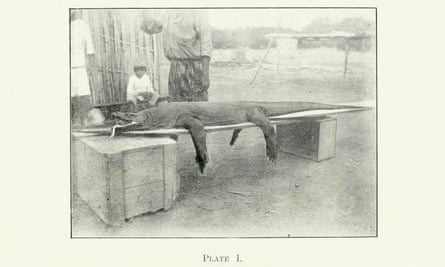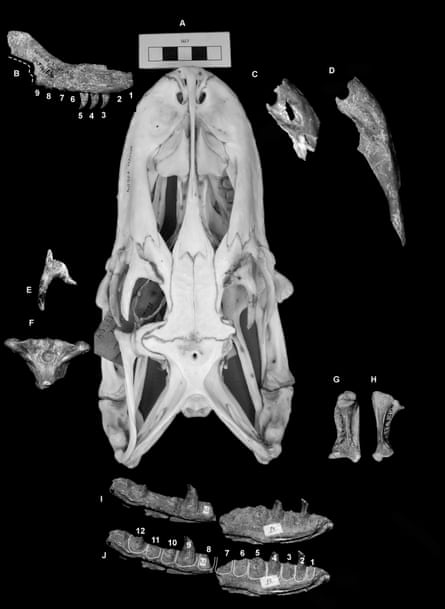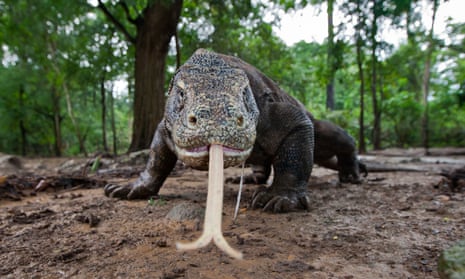In 1910, Lieutenant Jacques Karel Henri van Steyn van Hensbroek was stationed on Flores Island in eastern Indonesia within the Dutch colonial administration, when he received word of a “land crocodile” of unusually large size living on the nearby island of Komodo. Intrigued, he set out to Komodo to investigate for himself. He returned with a photo and the skin of the animal, which he sent to Pieter Ouwens, then director of the Java Zoological Museum and Botanical Gardens in Buitenzorg (now Bogor). The animal was not a crocodile of any sort, but a large monitor lizard. Ouwens realised that this animal was new to science and published the first formal description of the animal, which we know now as Komodo dragon, Varanus komodoensis (Ouwens, 1912).

Although fossils of giant varanids had been known since the mid-1800s, the discovery that giant lizards were still among us, albeit on a few isolated islands in far-away Southeast Asia, was met with fascination and excitement. Zoologists set out to collect more specimens, some of which were even brought back to Europe alive, and various aspects of their biology were studied. The discovery is even said to have been the inspiration behind the movie King Kong. But it wasn’t until 1969, when a herpetologist at the Florida Museum of Natural History, Walter Auffenberg, relocated with his family to Komodo island, that the first long-term study of Komodo dragons began. Together with his assistant Putra Sastrawa, Auffenberg tagged and studied over 50 wild Komodo dragons, resulting in the seminal work The Behavioral Ecology of the Komodo Monitor.
Komodo dragons are endemic to eastern Indonesia and are currently only found on the northern coast of Flores and on the nearby islands of Komodo, Rinca, Gili Motang and Nusa Kode (Purwandana et al., 2014). Adults can reach up to 3 meters in length, and with their powerful tail, large claws and serrated teeth, they do live up to their fearsome reputation. As large-bodied carnivores, adult Komodo dragons dine predominantly on large herbivores such as deer and pigs, which they ambush alongside trails, supplemented with birds and small mammals, and the occasional tourist (although my guide ascertained me that the last tourist, a Swiss, had been in eaten in 1974). Yet despite their awe-inspiring physique, Komodo dragons are shy creatures that will avoid encounters with humans. In some areas, you will have to put a goat out for 3 days before a Komodo dragon will show himself. Today, only ~2,500 Komodo dragons are thought to survive in the wild (Purwandana et al., 2014), and continuing habitat destruction threatens their already limited distribution, making them even more vulnerable to extinction.
Most of the modern day Komodo dragon’s diet consists of animals that are not native to the area. The Lesser Sunda islands, of which Flores and the other islands are part, were never connected to mainland Asia. Up until the Late Pleistocene, the only large herbivores present on the islands were dwarf elephants. Deer and pigs were introduced to the islands by modern humans some 4-5,000 years ago (van den Bergh et al., 2009). This led some scientists to suggest that Komodo dragons had evolved from a small-sized ancestor, and only evolved larger body sizes after their arrival to the Flores archipelago. In the absence of mammalian carnivores, a larger body size would enable Komodo dragons to fill the niche of top predator in the hunt for pygmy elephants (Diamond, 1987).
Over the last decades, however, this interpretation of Komodo dragon body size evolution has changed, mostly because of the findings of large and giant fossil monitor lizards across Indonesia and Australia. The oldest fossils of Varanus komodoensis stem from the late Pliocene (~3 million years ago) of mainland Australia, and they are already similar in size to living Komodo dragons (Hocknull et al., 2009). This indicates that Komodo dragons originated in Australia alongside a variety of marsupial megafauna, rather than in isolation on Komodo or Flores. Moreover, the Australian material indicates that Komodo dragons attained large size early on in their evolution.

From Australia, Komodo dragons spread westwards, but when this happened is not known. Fossils from Flores’ hot central region indicate that Komodo dragons first appeared on the island around one million years ago, and lived alongside pygmy elephants, giant tortoises and giant rats, and continued to do so for thousands of years.
Fossil evidence from Timor and Sumba indicate that as varanids spread westwards from Australia into Asia during the beginning of the Pleistocene, they radiated into several species. Varanids may even have crossed the Wallace’s line and reached Java, as evidenced by a fossil varanid from the island with affinities to Komodo dragons (Hocknull et al., 2009). At the same time, the radiation of varanids in Australia gave rise to an even larger varanid, Varanus priscus, (also known as Megalania) whose length may have reached a whopping 7 meters (Molnar, 2004), making it the largest terrestrial lizard ever.
None of these lacertian giants survived the Pleistocene era. For the Javan and Timorese varanids, only a handful of bones remind us of their existence, and the timing of their extinctions remains unknown. In Australia, Varanus priscus co-existed briefly with the first humans on the continent (Price al., 2015), before it disappeared in the Late Pleistocene, making it very likely that the first humans in Australia set eyes on one of these behemoths.
On Flores, evidence from Liang Bua, a limestone cave on the western part of the island, shows that Komodo dragons lived alongside pygmy elephants, small hominins (Homo floresiensis), giant scavenging storks and vultures until 50,000 years ago (Sutikna et al., 2016). But as its fellow islanders went extinct, populations of Komodo dragons contracted significantly. Nowadays, small populations survive on the islands’ northern coast and on the nearby islands that were once connected to Flores during low sealevels. There, the last of the king lizards survive. But for how much longer?
References
Diamond, JM, 1987. Did Komodo dragons evolve to eat pygmy elephants? Nature 326:832.
van den Bergh, GD, et al., 2009. The Liang Bua faunal remains: a 95 k.yr. sequence from Flores, East Indonesia. Journal of Human Evolution 57:527–537.
Hocknull, SA, et al., 2009. Dragon’s Paradise Lost: Palaeobiogeography, Evolution and Extinction of the Largest-Ever Terrestrial Lizards (Varanidae). PLoS ONE 4(9): e7241.
Molnar, RE, 2004. Dragons in the dust: the paleobiology of the giant monitor lizard Megalania. Bloomington: Indiana University Press.
Price, GJ, et al., 2015. Temporal overlap of humans and giant lizards (Varanidae; Squamata) in Pleistocene Australia. Quaternary Science Reviews 125:98–105
Purwandana et al., 2014. Demographic status of Komodo dragons populations in Komodo National Park. Biological Conservation 171:29-35.
Sutikna, T, et al., 2016. Revised stratigraphy and chronology for Homo floresiensis at Liang Bua in Indonesia. Nature 532:366–369.

Comments (…)
Sign in or create your Guardian account to join the discussion